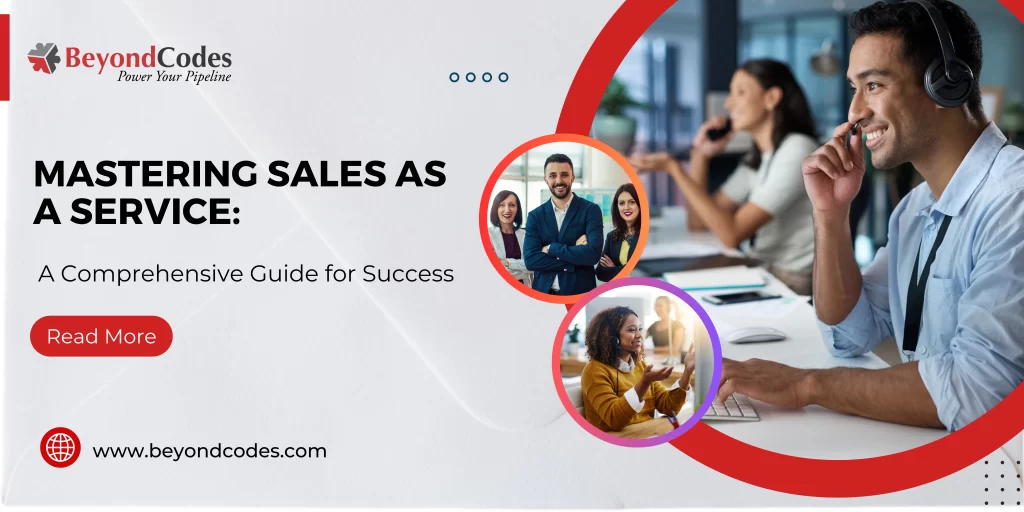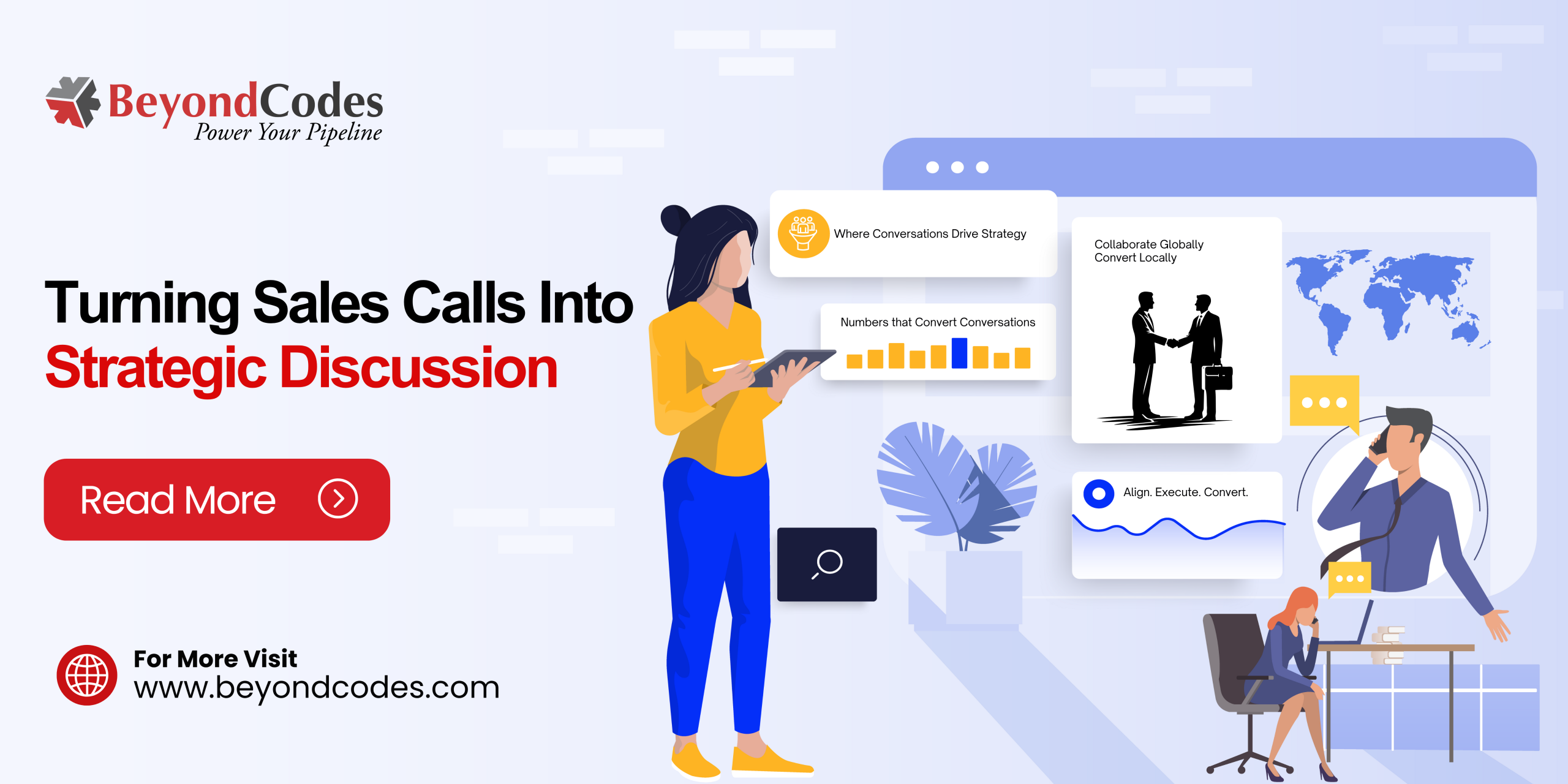Every business’ success hinges on the sales department in some way. Sales increase clients’ loyalty and trust in the company. Businesses continuously search for novel approaches to boost sales and stay ahead of the curve in today’s competitive business environment. Startups and Fortune 500 organizations are outsourcing their sales force. The term “outsourcing” has now changed to “Sales-as-a-Service” (Saas), which is rapidly gaining popularity. By enhancing your sales process, generating revenue, and maximizing customer satisfaction, SaaS can help you increase your B2B sales.
This article will thoroughly explain what Sales as a Service is, how it works, what it may offer, and what challenges it might encounter.

What is Sales as a Service?
A business model, Sales as a Service (SaaS), enables organizations to work with qualified service providers to handle sales-related tasks.
According to this approach, businesses deal with a third-party entity to handle the sales process and all or a portion of the sales team. Companies that sell SaaS products use various techniques, such as focusing on untapped markets or target audiences that have yet to interact with your company. In addition to saving businesses time and money, it offers clients excellent customer service.
To assist organizations in generating revenue and achieving their sales objectives, SaaS entails collaborating with a third-party provider of sales-related services that offers various sales process components.
The Step-By-Step Guide on How Sales as a Service Work
The SaaS process often begins with a thorough meeting between the client and the SaaS provider to comprehend the client’s sales goal, target market, and ideal customer profile.
Here is a guide you need to follow to comprehend the SaaS process:
Needs Evaluation: The client company and the sales service provider interact to ascertain the customer’s unique sales requirements. It involves being aware of the client’s target market, sales objectives, features of the product or service, and other pertinent elements.
Sales Strategy Development: The sales service provider develops a customized sales plan based on the client’s requirements. The approach, messaging, methods, and techniques used to generate leads, nurture prospects, and close deals are covered in this strategy.
Lead Generation: It is the process by which a sales service provider finds potential clients interested in a client’s products or services. Cold calling, email marketing, prospecting on social media, content marketing, and advertising are all included.
Prosecting & Qualification: The sales team calls the generated leads to gauge their interest, needs, and likelihood of purchasing. This process is known as prospecting. The sales service provider identifies the most promising opportunities for further interaction by qualifying and analyzing prospects.
Sales Outreach: The sales team contacts qualified leads via phone, email, or in-person meetings using tailored communication channels. They focus on developing relationships, comprehending customer demands, resolving issues, and emphasizing the value of the client’s services.
Sales Demos & Presentations: Sales service providers conduct demonstrations and presentations of products to highlight their features, advantages, and capabilities. These presentations are created based on the prospect’s demands and interests to communicate the value and generate interest.
Sales Closing: The sales team strives to turn interested parties into paying clients. They help to complete the sales deal by helping to negotiate terms, client handling challenges, and offer pricing information.
Post-Sale Support: Depending on the client agreement terms, the sales service provider even offers support after the sale to guarantee customer satisfaction. It includes onboarding, guidance, client support, and upselling or cross-selling more products and services.
Reporting & Analytics: To assess the success of the sales strategy, the sales service provider monitors and examines KPIs at various stages of the sales process. Clients can make informed decisions and improve their sales strategy through regular reports and insights.
Quick Tip: Ready to transform your sales process to reap amazing results? With Beyond Codes, you can harness the potential of Sales as a Service. With our proven track record of achieving results for startups and Fortune 500 companies, we offer customized Sales service solutions to meet your specific goals.
Benefits of Sales as a Service You Must Know
This SaaS method provides numerous benefits to companies of all sizes and industries. Let’s look at some of the essential benefits of Sales as a Service:
Cost-Effective: Instead of spending high costs on hiring, training, and managing an in-house sales force, businesses can outsource their sales function to a specialist provider. This method saves money on the workforce, benefits, infrastructure, and continual training.
Adaptability: SaaS enables organizations to grow their sales efforts rapidly. Because the provider already has a sales team, they can easily assign more resources based on the client’s needs. This adaptability enables firms to rapidly expand or contract their sales activities in response to market demand.
Focus on Core Competencies: By outsourcing sales, businesses may focus on their core competencies and strategic projects. With the sales function outsourced, internal staff may focus on product development, customer service, and other critical areas that drive business success.
Faster Time to Market: SaaS providers already have lead-generating, prospecting, and nurturing procedures. It can help you capitalize on opportunities faster by drastically reducing the time it takes to sell your product or service.
Expertise & Experience: SaaS vendors bring a wealth of sales knowledge and experience. Their employees know sales strategies, best practices, and recent tools and technologies. Businesses can use their knowledge and abilities to implement tried-and-true techniques and drive sales growth.
Challenges of Sales as a Service with Solutions
Adopting Sales as a Service can be a game changer for businesses looking for more effective ways to grow revenue and expand their customer base. However, an in-depth understanding of the issues it brings is required to realize its potential fully.
Let’s check out a few of the common challenges with solutions-
Integration and Alignment: Successful sales outcomes require effective collaboration and alignment between the SaaS provider and the client’s internal teams. Integrating external sales with existing marketing, customer service, and product teams can be challenging.
Solution: Through clear communication and coordination, ensure effective collaboration and alignment between the SaaS supplier and the client’s internal teams for successful sales outcomes.
Brand Representation: Organizations must verify that the SaaS provider accurately represents their brand and values while outsourcing sales. The gap grows when the sales team cannot properly engage with potential customers as an extension of the client’s brand due to a lack of understanding of the client’s products or services, target market, and messaging.
Solution: To overcome this issue, build a close relationship with the SaaS provider and provide detailed brand, product knowledge, and target audience training. Maintaining a consistent, accurate portrayal of the client’s brand values requires continuous feedback.
Data Security: Sharing sensitive client data and sales-related information with a third-party provider necessitates robust data protection measures and strict confidentiality agreements. It happens when SaaS providers don’t maintain client trust and aren’t analyzing their security standards carefully.
Solution: To retain confidence, evaluate and execute rigorous data security procedures and stringent confidentiality agreements with the SaaS provider.
Key Steps to Implement Sales as a Service Successfully
Successfully implementing Sales as a Service necessitates a strategic approach and meticulous planning. Here are the essential stages to accomplishing this:
Market Analysis: Do extensive market research to discover potential clients and target markets. Understand their needs, pain areas, and preferences to tailor your sales technique.
Define Goals and Objectives: Outline your sales objectives and targets in a way that is consistent with your overall business strategy. It will help select the best Sales as a Service provider and set performance goals.
Select the Best Provider: Research and assess various Sales as a Service providers to identify the one that best meets your requirements. Consider industry knowledge, track record, technical capability, and cultural fit.
Collaborative Partnership: Create open communication channels and collaboration with your Sales as a Service provider. Maintain regular updates, feedback, and alignment on sales plans and targets by treating them as an extension of your team.
Lead generating & Nurturing: Create a solid lead generating and nurturing process to continuously attract and engage new clients. To create leads, use multiple channels such as social media, content marketing, and email campaigns.
Client Onboarding: Streamline the onboarding process for new clients to ensure a smooth transfer and clear expectations. To foster long-term partnerships and provide great customer service throughout their engagement.
Metrics and KPIs: Define key performance indicators (KPIs) to track the success of the Sales as a Service model. To analyze performance and make data-driven decisions, track indicators such as conversion rates, client retention, and customer satisfaction.
Continuous Improvement: Analyze data and client comments regularly to find opportunities for improvement. Improvements and optimizations should be implemented to improve the effectiveness of your Sales as a Service offering.
Quality Assurance: Ensure consistency in service quality throughout all sales engagements. Execute quality assurance processes to ensure the highest standards are met and customers receive outstanding value.
Promotion & Marketing: To reach a larger audience, promote your Sales as a Service model through many marketing channels. To attract potential clients, emphasize the benefits and success stories.
Final Thoughts
The changing sales landscape has evolved from traditional in-house sales teams. What has stayed the same is your aggressive sales targets, even in the midst of a global epidemic and unprecedented economic turmoil.
Sales businesses today face challenges they never imagined. In this unprecedented era, Sales as a Service is a reliable approach for enterprises to boost their sales cost-effectively, strengthen their existing customer base, and grow. After COVID, outsourcing a portion of your sales responsibilities will allow you to deploy a dedicated team in a fraction of the time.
Are you ready to embrace the benefits of Sales as a Service and take your sales performance to new heights? Consider Beyond Codes as your reliable partner and explore the possibilities that can boost your business.
Author
-
With 7+ years of experience and a background in media & communication, she brings stories to life that fuel lead generation success. She transforms complex B2B ideas into content that is clear, engaging, and results-driven—helping key decision-makers take action. A good cup of coffee fuels her writing ideas, and when off the clock, she enjoys unwinding with her dog by her side.







